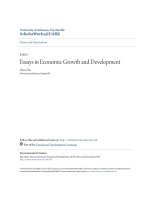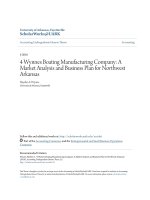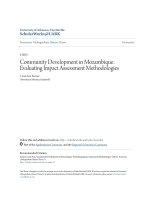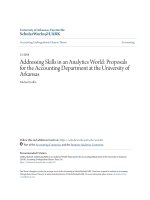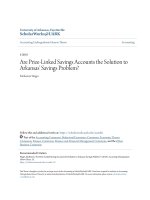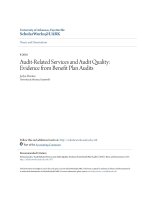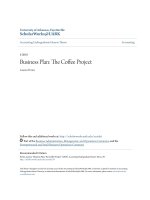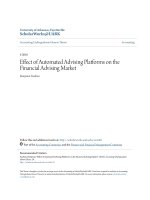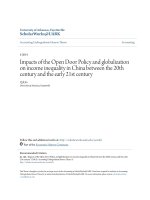Accounting undergraduate Honors theses: Essays on international trade and finance
Bạn đang xem bản rút gọn của tài liệu. Xem và tải ngay bản đầy đủ của tài liệu tại đây (6.31 MB, 139 trang )
University of Arkansas, Fayetteville
ScholarWorks@UARK
Theses and Dissertations
5-2012
Essays on International Trade and Finance
Amat Adarov
University of Arkansas, Fayetteville
Follow this and additional works at: />Part of the Finance Commons, International Economics Commons, and the Macroeconomics
Commons
Recommended Citation
Adarov, Amat, "Essays on International Trade and Finance" (2012). Theses and Dissertations. 307.
/>
This Dissertation is brought to you for free and open access by ScholarWorks@UARK. It has been accepted for inclusion in Theses and Dissertations by
an authorized administrator of ScholarWorks@UARK. For more information, please contact ,
ESSAYS ON INTERNATIONAL TRADE AND FINANCE
ESSAYS ON INTERNATIONAL TRADE AND FINANCE
A dissertation submitted in partial fulfillment
of the requirements for the degree of
Doctor of Philosophy in Economics
By
Amat B. Adarov
Altai State Technical University
Bachelor of Arts in Economics, 2003
University of Arkansas
Master of Arts in Economics, 2007
May 2012
University of Arkansas
ABSTRACT
The dissertation consists of three papers exploring the macroeconomic implications of
heterogeneity of countries in financial development, economic interconnectedness via trade and
financial linkages.
Chapter 1 examines whether countries which are more centrally located in the global
trade network have more synchronized stock markets. Global trade data is used to construct a
novel measure of random walk betweenness centrality (RWBC), measuring the extent to which a
country lies on random pathways in-between other countries and is therefore likely to be a
conduit in the transmission of a shock across global markets. Based on a panel dataset of 58
countries over the period 1990–2000, the study finds that higher centrality of a country in the
world trade network is indeed associated with greater stock market synchronicity, ceteris paribus.
Chapter 2 uses aggregate macroeconomic experiences of 118 countries over the period
1994–2008 to establish benchmark relationships between macroeconomic fundamentals and
levels of financial development of the banking sector, equity markets, and private bond markets.
The analysis quantifies the extent to which de-facto financial development of emerging market
economies (EMEs) deviates from the levels predicted by their macroeconomic stance. While
financial markets in Latin American EMEs are found to be well aligned with their
macroeconomic fundamentals, Asian EMEs exceed their reference levels, and European EMEs
are found to be systematically financially underdeveloped. No support is found for the argument
that these misalignments are caused by heterogeneity in institutional development.
Finally, chapter 3 studies the properties and evolution of the product space—a network of
relatedness between products. We use bilateral trade data for 187 countries to construct the
product space and export specialization of individual countries over the period 1965—2000. The
study shows that the product space changed significantly during the 20th century and represents
a highly uneven core-periphery structure. The highly interconnected core consists of three
industries—chemicals, industrial machinery, and crude materials, each forming around 20% of
all linkages. Product synergies that these “commanding heights” industries yield are strategically
important for industrialization policies. Regression analysis confirms that specialization in these
industries is associated with higher real income levels.
This dissertation is approved for recommendation to the
Graduate Council
Dissertation Directors:
_______________________________________
Dr. Raja Kali
_______________________________________
Dr. Javier A. Reyes
Dissertation Committee:
_______________________________________
Dr. Gary D. Ferrier
DISSERTATION DUPLICATION RELEASE
I hereby authorize the University of Arkansas Libraries to duplicate this dissertation
when needed for research and/or scholarship.
Agreed __________________________________________
Amat B. Adarov
Refused __________________________________________
Amat B. Adarov
ACKNOWLEDGEMENTS
I am grateful to my dissertation co-chairs Javier Reyes and Raja Kali for their invaluable
guidance and support. Special thanks are due to Gary Ferrier for insightful comments that helped
improve the quality of the dissertation. I am in debt to all my friends and colleagues at the
Department of Economics for making the years in the doctorate program so pleasant.
My gratitude goes to all my friends around the world whose support was crucial to me.
Finally, and most importantly, I am extremely grateful to my parents, Boris and
Aleksandra, and my sister, Aradyana, for their continuous love and encouragement.
DEDICATION
To my parents, Adarov Boris and Adarova Aleksandra.
TABLE OF CONTENTS
Introduction ……………………………..………………………………………………………. 1
Chapter 1: Stock Market Synchronicity and the Global Trade Network:
a Random-Walk Approach …………………………………………………….……….. 4
Chapter 2: Macroeconomic and Institutional Determinants of Financial
Development: Implications for Emerging Markets …………………………………..... 43
Chapter 3: International Trade and Export Specialization Dynamics:
a Network Perspective ………………………………………………………………..... 83
Conclusion …………………………………..…………………………………….……..…… 127
INTRODUCTION
The dissertation consists of three papers exploring the macroeconomic implications of
heterogeneity of countries in financial development, economic interconnectedness via trade and
financial linkages.
In Chapter 1, recent advancements in network theory are used along with conventional
panel data techniques to analyze cross-border financial synchronicity and propagation of
financial shocks. The central question is whether countries that are better integrated into the
world economy and more centrally located in the global trade network have more synchronous
financial markets. The paper uses a novel measure of random walk betweenness centrality
(RWBC) to gauge the extent to which a country lies on random pathways in-between other
countries in the global trade network and is therefore likely to be a conduit in the cross-border
transmission of a shock resulting in higher stock market synchronicity. Based on a panel dataset
of 58 countries over the period 1990-2000 the analysis demonstrates that higher centrality of a
country in the world economy is indeed associated with higher synchronicity, ceteris paribus.
The analysis also reveals that the global trade network has a well-defined core-periphery
structure, where the highly interconnected core, comprising China, France, Germany, Italy,
Japan, and the UK, is characterized by significantly lower synchronicity. The study has
important policy implications as it demonstrates the importance of network centrality in the
world economy for understanding financial synchronicity and global shock propagation. This
contrasts sharply with conventional measures of economic integration, e.g. trade openness,
which do not reflect the risks associated with economic partners. Therefore, the network-based
approach may serve as an important tool for monitoring systemic risks and resilience of the
world economy, as well as risk exposures of individual countries to financial shocks.
1
Chapter 2 examines an often-sounded claim that financial markets of emerging market
economies (EMEs) are weak, and this is primarily the result of institutional impediments. Based
on aggregate experience of 118 countries excluding EMEs over the period of 1994-2008 I find
that financial development measured by financial market size can be consistently related to a
country's general stage of economic development (proxied by real per capita income), economic
openness, inflation, and inflation volatility. Then, I use a full sample of countries and original
specification augmented by fixed effects for major EME groups to test if there is any residual
effect pertinent to EMEs that is unexplained by macroeconomic fundamentals. Notably, while
financial markets in Latin American EMEs are found to be well-aligned with their
macroeconomic parameters, European EMEs are underperforming and Asian EMEs are
overperforming relative to their expected levels. However, the quality of institutions does not
contribute much to explaining these misalignments.
Finally, in Chapter 3, bilateral trade data on 1006 product categories (SITC4
classification) for 187 countries over the period 1965-2000 is used to construct the product
space—a network of relatedness between nodes-products, where the weight of a link between
individual products is proportional to the probability that they are produced and exported
together. Along these lines, export specialization of a country is a subnetwork of the product
space formed by products in which it enjoys revealed comparative advantage (RCA). Network
properties and evolution of the product space and export specialization patterns of individual
countries are then examined in order to understand their implications for economic development.
The paper demonstrates that the product space changed significantly during the twentieth century
and evolved into a highly uneven core-periphery structure. Specifically, the highly
interconnected core consists of only three industries—chemicals, industrial machinery, and crude
2
materials—each forming around 20 percent of all product linkages. Product synergies that these
commanding heights industries yield are strategically important for industrialization policies.
Regression analysis confirms that specialization in the commanding heights industries is
associated with higher real income levels, controlling for other relevant factors.
3
CHAPTER 1
STOCK MARKET SYNCHRONICITY AND THE GLOBAL TRADE NETWORK: A
RANDOM-WALK APPROACH
The chapter is based on the paper “Stock Market Synchronicity and the Global Trade
Network: a Random-Walk Approach” by Amat Adarov, Raja Kali, and Javier A. Reyes.
1.1. Introduction
During the past decade, one of the most prominent themes sounded by policymakers,
observers, and analysts of international economic development has been “globalization.” The
world economy has become tightly knit via economic and financial interdependence among
nations. Recently however, as the housing sector in the United States slowed sharply and turmoil
erupted in many financial markets, a different theme has come to the foreground: “decoupling.”
This refers to the apparent divergence in economic performance among different regions of the
world economy. In the context of these opposing discussions it seems reasonable to ask, to what
extent does integration into the global economy influence synchronized movements in markets
around the world? Are there meaningful differences between groups of countries in this
relationship?
In this paper, we aim to cast some light on these issues by focusing on a narrow version
of the questions above. Specifically, how does integration into the global economy affect
synchronicity in financial markets? Our approach involves two methodological novelties. First,
we construct a network of economic connectedness among nations by using the NBER–United
Nations World Trade Database associated with Feenstra et al. (2005). We view individual
4
countries in the world trade network as nodes connected by bilateral trade linkages that are
weighted by trade volume. Our assumption here is that the global trade network is a meaningful
proxy for economic connectedness among nations, and that alternative proxies of the global
economic network are likely to be closely related to the trade network, e.g. a network of bilateral
capital flows is linked to trade flows via the balance of payments. As trade linkages are relatively
stable over time, highly correlated with other cross-country linkages1, and we are primarily
interested in stock market synchronicity over a relatively long time horizon (1990–2000), this
seems particularly suitable.
Second, we use a novel approach to computing country-level connectedness that is
agnostic about the way in which each country receives and transmits shocks. Specifically, based
on the notion of random walk betweenness centrality introduced in Newman (2005), for each
country in our sample we compute its random walk betweenness centrality in the world trade
network (RWBC). In brief, random walk betweenness centrality of node i is equal to the number
of times that a random walk starting at s and ending at t passes through i along the way, averaged
over all possible combinations of s and t in the network. In computing RWBC, we assume that
the probability that a financial shock follows a particular link along its propagation path in the
trade network is proportional to the intensity of bilateral trade flow the link represents.
Hence, in the context of the world trade network, RWBC summarizes the connectedness
of a country in the world economy and its ultimate exposure to a financial shock that can
originate anywhere in the system and spread through the network in a manner that is not
1
There is increasing evidence that financial flows depend on the information afforded by trade in
goods and are predicted by the same gravity model that captures trade in goods (Kalemli-Ozcan
et al., 2001, 2003). Also, theoretically, a balance of payments view suggests integration in the
goods and assets markets may go hand in hand (Rajan and Zingales, 1998; Fisman and Love,
2004).
5
necessarily optimal. An attraction of this measure is that it is agnostic about which path a shock
actually takes between any particular “epicenter” country and a “target” country with regard to
the transmission of shocks. Since the propagation mechanism of international economic shocks
is not well understood, with different hypotheses vying for attention in the literature, this
approach seems especially useful as it does not favor one transmission mechanism over another.
We then examine whether a position of a country in the world trade network contributes
to explaining financial synchronicity. Financial synchronicity is measured as comovement
intensity between stock market indices of individual countries and the index of a benchmark
economy (in our case, the USA and the Dow Jones Industrial Average) that is inspired by the
work of Morck, Yeung and Yu (2000). If stock prices are based mainly on the capitalization of
country-specific information we expect a low degree of synchronicity, while greater degree of
interdependence will be reflected in higher synchronicity, ceteris paribus.
Our basic hypothesis is then formulated as follows. Other things equal, a country that has
a high measure of random walk betweenness centrality lies on more random pathways inbetween countries and is therefore more likely to be affected by an external shock, regardless of
the exact transmission mechanism, than a country with lower RWBC. This will be reflected in a
higher level of stock market synchronicity of a high-RWBC country than a low-RWBC country.
Our empirical analysis supports this hypothesis. Greater connectedness of an economy in
the global trade network as measured by RWBC is associated with higher stock market
synchronicity, after controlling for other relevant characteristics. However, we find that a group
of nations that are highly central in the global trade network (we refer to them as the “core” of
the network) are characterized by uniformly lower financial synchronicity than others. The highRWBC core is comprised of the UK, Germany, France, Italy, China, and Japan.
6
In terms of the literature, only a few studies have attempted to take into consideration
multilateral linkages in the global economy to explain stock market correlations. Forbes and
Rigobon (2002) find that trade linkages are important factors for stock market dynamics and
therefore a country’s susceptibility to financial crisis. Reinhart and Kaminsky (2008) analyze the
three emerging markets that experienced financial crises in the late 1990s: Brazil, Russia, and
Thailand, and suggest that financial turbulence in these countries spreads globally only when the
shock reaches world financial centers and remains local otherwise. A recent paper by Kali and
Reyes (2010) explicitly uses a network approach to international economic integration to study
financial crisis episodes and associated contagion.
A separate strand of the literature, pioneered by Imbs (2004, 2006), focuses on business
cycle synchronization and uses simultaneous equations systems to disentangle the complex
interactions between trade, finance, specialization, and business cycle synchronization. The
overall effect of trade on business cycle synchronization is confirmed to be strong and a sizable
portion is found to work through intra-industry trade.
Our approach here is differentiated from the prior literature along several dimensions.
Most importantly, we apply a network approach to understand stock market synchronicity. Using
the network of global trade linkages enables us to use a completely multilateral approach to the
propagation of financial shocks. Our measure of network position, RWBC, is novel to the
literature and well-suited to the application. Second, unlike most studies we address stock market
synchronicity over the long run rather than focusing on financial turmoil periods alone. This is an
important distinction because financial crisis years are likely to be characterized by downward
financial trends in stock markets resulting in a bias towards higher synchronicity values. Our
empirical analysis is based on a panel dataset spanning the 1990–2000 period that includes both
7
tranquil periods and periods of economic crises. Third, we assess stock market synchronicity of a
wide range of countries from diverse regions of the world and different in terms of economic
development to ensure results are not driven by individual country properties2.
The rest of the paper is organized as follows. Section 2 discusses our empirical strategy
and data. Regression results are discussed in Section 3. Section 4 presents concluding remarks.
1.2. Research framework and data
The question the paper focuses on is whether more interconnected economies have more
synchronous stock market dynamics. In order to test this hypothesis, in this section we first
develop a measure of stock market synchronicity and a measure of interconnectedness among
individual economies – RWBC. We also recognize that other macroeconomic factors can
potentially affect the degree of financial synchronicity and consider control variables deemed to
be relevant in the related literature. Then, the benchmark econometric specification is described.
1.2.1. Stock market synchronicity
Computation of a stock market synchronicity measure that is comparable across countries
requires selection of a common benchmark country and associated stock market index to which
all other countries are compared. We use the United States of America as the benchmark country
and the Dow Jones Industrial Average (the DJIA) as the benchmark index3. Based on our
2
We would be remiss not to mention a rich strand of work in finance that uses cointegration
methods to demonstrate international stock market interdependence. However, this literature
does not concern itself with the channels of transmission and is therefore orthogonal to our focus.
Noteworthy papers are Awokuse, Bessler and Chopra (2009) and Arshanapalli and Doukas
(1993).
3
We use the DJIA index as it is the most widely recognized of the stock market indices. We
realize it is often criticized, e.g. for being a price-weighted measure, which affects its accuracy as
8
methodology, the US is the most integrated country in the world economy as identified by
centrality in the global trade network, and, in general, it is hard to find a better representative
financial center by any standard.
Stock market index data are obtained from the Bloomberg stock market database, where
each data point represents a daily stock market index closing value. Our dataset comprises 58
countries between the 1990–2000 period. For each country in the sample we identify a
representative stock market index and employ several techniques to compute its synchronicity
with respect to the benchmark index, the DJIA. Our main analysis is based on two synchronicity
measures, denoted further as Synch(FREQ) and Synch(R-SQ), that are inspired by the synchronicity
measures of Morck, Yeung and Yu (2000). We also use a third viable measure denoted as
Synch(CORR) as a robustness check4. Here we provide a detailed description of how the two
baseline synchronicity variables are developed.
Calculation of Synch(FREQ) involves two steps. First, we compute the frequency of stock
market index comovements in year t for country i as a simple fraction:
Frequency i ,t
Comovementsi ,t
Daysi ,t
(1)
an index representing the entire stock market. However, the DJIA daily dynamics closely follow
other widely recognized indices, e.g. the correlation coefficient between the DJIA and the
S&P500 daily values over the period 01/01/1990 – 01/01/2000 is 0.996. Therefore, choosing one
index as a benchmark over others should yield identical results.
4
The calculation methodology and empirical results for Synch(CORR) are discussed in Section 3.3
“Robustness checks”.
9
where Comovementsi,t is the number of days in year t in which stock market index of country i
moves in the same direction as the DJIA, and Daysi,t is the total number of days for which both
stock markets were operating in year t.
Equation (1) provides an intuitive assessment of stock market comovements with the
benchmark US equity market at daily frequency for a given year. For instance, in the case of
Brazil and its representative stock market index, the Bovespa Index, comprised of the most liquid
stocks traded on the Sao Paulo Stock Exchange, the frequency value in year 2000 is 0.6929,
implying the Bovespa Index moved in the same direction as the DJIA 69.29% of days. Figure 1
lists the frequency of stock market comovements for all countries assessed in our study.
[Insert Figure 1 here]
However, the computed frequency variable is confined in the interval of [0,1] and
therefore cannot be used in our regression analysis directly. In order to map frequency values to
the real number set we apply the standard statistical technique of logistic transformation as
follows:
Frequency i ,t
Synchi(,tFREQ ) Ln
1 Frequency i ,t
(2)
Hence, our first stock market synchronicity measure, Synch(FREQ), is merely a logistic
transformation of stock market comovements frequency. Although it is a simple measure, we
believe it is adequate for our purposes and is robust to most issues associated with alternative
10
measures as we keep track only of the direction of stock market index dynamics. Synch(FREQ)
values for the year 2000 are presented in Figure 25.
[Insert Figure 2 here]
Another measure of stock market synchronicity used in our formal analysis, Synch(R-SQ),
is based on a goodness-of-fit approach rather than a fraction of comovement days:
R 2 i ,t
Synchi(,Rt SQ) Ln
2
1 R i ,t
where
R2i,t
is
the
coefficient
of
determination
(3)
from
the
linear
regression
Indexi ,t * DJIAi ,t i ,t , regressing daily stock market index values of country i in year t (in
log-differenced form) on those of the DJIA. Again, as the coefficient of determination is
bounded in the [0,1] interval, we apply logistic transformation to map the variable to the real
number set.
We construct a panel dataset for synchronicity based on daily closing stock market values
with appropriate adjustments made for time zone differences in the operation of corresponding
stock exchanges. For instance, a shock affecting the New York Stock Exchange on December 1
is reflected in the US in the reported December 1 daily closing prices, while the London Stock
Exchange would reflect the effects of this shock, if any, in the reported December 2 daily closing
prices because of the time zone difference. Therefore, in calculations of synchronicity measures
5
For brevity we present diagrams for the Synch(FREQ) variable only, as all three stock market
synchronicity measures that we develop in the study are highly correlated (see Table 1) and
diagrams for Synch(R-SQ) and Synch(CORR) look virtually identical to those of Synch(FREQ).
11
we ensure the data is within the same frame of reference by lagging stock market index values by
one day for stock exchanges located to the east of New York (hence, all countries not located in
North America or South America), e.g. local index values reported in non-American economies
on December 2 would correspond to the DJIA values reported in the US on December 1. In
addition, for robustness we drop synchronicity values which are based on less than 100 days of
equity market data reported per year since we believe these to be unreliable.
We acknowledge the fact that our synchronicity measures are imperfect since there can
be scenarios which may or may not be captured by them explicitly. For example, if capital
market-relevant news or events are announced after a stock market is closed for the day, the
effects would be reflected in the next day’s price, but there is no way to control for this unless we
had an explicit “news” indicator. Recent studies that have looked at the effects of
macroeconomic news (economic information) on stock market prices, e.g. Albuquerque and
Vega (2009), Karolyi and Stulz (1996), McQueen and Roley (1993), Wongswan (2006), examine
the mechanisms of price discovery and spillovers on interdependent asset markets after public
economic news releases. Notably, the literature suggests that the effect of macroeconomic
announcements on stock market comovements manifests itself in high-frequency stock market
data (daily or intra-day return dynamics), and in this case constitutes an important source of
international stock market comovements. At low frequencies the effect is minimal.
In fact, our synchronicity variables take advantage of high-frequency (daily) stock market
data, and can be viewed as statistics summarizing the daily dynamics of relevant macroeconomic
fundamentals and the effect of economic news. However, our analysis differs from this literature
as we focus on systematic factors that explain cross-country stock market synchronicity over a
long time horizon.
12
It could also be the case that a shock may affect different markets with a time lag for
simple reasons, like holidays, or more complicated ones, such as markets not fully realizing the
extent of the effects due to such factors as regulations by domestic or international agencies
(central banks, rating agencies, etc.). Despite these potential shortcomings of the synchronicity
measures, we believe that, given large sample size, the impact of anomalous adjustments due to
the reasons mentioned here is minimal.
Summary statistics and pairwise correlations between the three alternative stock market
synchronicity measures Synch(FREQ), Synch(R-SQ) and Synch(CORR) are reported in Table 1. As
correlations between the three synchronicity measures are fairly high, we expect regression
results to be similar regardless of the particular choice of the synchronicity variable.
[Insert Table 1 here]
1.2.2. Random walk betweenness centrality (RWBC)
Our hypothesis of interest calls for the application of a measure that is a proxy for the
degree of economic interconnectedness among countries. We believe a measure of economic
integration that is based on network approach is superior to conventional measures of integration
relying on trade or investment intensity and not taking into account asymmetries in the world
economy that are captured by network modeling. Connectedness of a country in the global
economic network seems to be especially important for understanding how financial shocks
spread across countries. Therefore, we derive a measure of random walk betweenness centrality
of a country in the global trade network, denoted further as random walk betweenness centrality
or RWBC.
13
In the networks literature centrality is a measure that summarizes the position of a given
node in the network based on the value of its relations, and relations of the nodes it is connected
to. There are different measures of centrality (binary and weighted) that are based on closeness
or betweenness. We use random walk betweenness centrality, first suggested by Newman (2005)
and later expanded by Fisher and Vega-Redondo (2006). Insightful discussion of the measure
and its technical properties is provided in Newman (2005).
In particular, he describes RWBC of a given node i as the number of times that a random
walk starting at node s and ending at node t passes through i along the way, averaged over a large
number of trials of the random walk for all possible source-target pairs of s and t. RWBC is most
appropriate for a network in which a signal spreads randomly and the actual paths along which it
travels are not necessarily optimal. Newman (2005) derives a sequence of equations to obtain
RWBC values for node i by manipulating a diagonal matrix of node degrees D and an adjacency
matrix A:
,
RWBCi =
where
s,t;
; n is the number of
nodes in the network, and matrix T is obtained by (1) inverting the matrix D – A with any single
row and a corresponding column removed, and (2) adding back a row and a column of zeros to
the position where they were removed in step 1.
Fisher and Vega-Redondo (2006) introduce important generalizations to matrix
methodology for obtaining RWBC for weighted directed networks, in particular, the MoorePenrose pseudo-inverse, which is more suitable for networks based on real economic data.
Following Newman (2005) and Fisher and Vega-Redondo (2006) methodology, Fagiolo, Reyes,
14
and Schiavo (2008) use international trade flows data provided in Gleiditsch (2002) to build time
series of weighted directed networks and compute RWBC values for 159 countries over the
period of 1981 to 20006.
[Insert Figure 3 here]
Based on the original bilateral trade data from the NBER-United Nations World Trade
Database associated with Feenstra et al. (2005), we construct a panel dataset of RWBC for the 58
countries assessed in our study over the period 1990–2000. Figure 3 shows RWBC data for our
sample for the year 2000. As can be seen, RWBC is not directly related to the level of economic
development, as, for instance, the low-RWBC range is comprised of both high-income and lowincome countries. At the same time, inequality in RWBC between individual economies is vast,
e.g. RWBC value for Malta is 18 times smaller than RWBC value for Germany. The benchmark
country of our analysis, the US, has RWBC value of 0.6297 in the year 2000, which is by far
higher than RWBC of any other country. This speaks in favor of the argument that the USA is a
good benchmark economy to relate other countries to. For comparison, the second-highest
RWBC economy in the sample is Germany with the value of only 0.2743.
Notably, the pairwise correlation coefficient between RWBC and trade openness,
measured as trade to GDP ratio, that is also used in our study is -0.24, implying the two variables
reflect rather different information about the degree of integration in the world economy. Hence,
6
The literature applying network perspectives to the study of international economic integration
has expanded substantially in recent years and the principal framework for this approach has
defined linkages in terms of international trade flows (in many cases weighted by GDP). Recent
studies in this area include Bhattacharya et al. (2007), Saramaki et al. (2007), Fagiolo, Reyes and
Schiavo (2008), Kali and Reyes (2007), Serrano et al. (2007).
15
